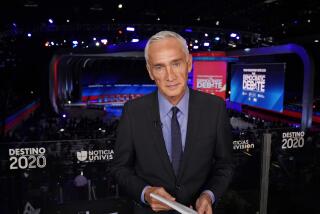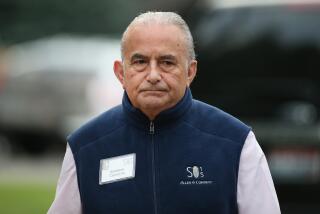Hallmark Cards to Sell Univision TV Network
- Share via
Hallmark Cards, which stirred controversy when it became the nation’s largest Spanish-language broadcaster four years ago, said Wednesday that it had reached an agreement to sell its nine TV stations and Univision TV network to a group led by investor A. Jerrold Perenchio for $550 million.
The sale would signal a dramatic upheaval in the Spanish-language TV market, as Univision likely would be merged with one of its top competitors, the Galavision network. Galavision is owned by the huge Mexican media conglomerate Grupo Televisa, a partner in Perenchio’s investor group.
Televisa in turn is controlled by Emilio Azcarraga, who was forced to sell Univision’s predecessor company in 1988, when the Federal Communications Commission found him in violation of rules governing foreign control of broadcasting licenses.
The sale also represents a major reversal for Kansas City-based Hallmark, which spent considerably more than the $550-million sale price acquiring Univision and then made substantial investments in programming.
Univision programming reaches 90% of the approximately 6 million Latino households in the country. But in recent years, the network’s ratings have slipped under challenges from Galavision and Telemundo, the third Spanish-language network. In Los Angeles, Univision owns KMEX Channel 34, and Telemundo owns KVEA Channel 52; KWHY Channel 22 is a Galavision affiliate.
Hallmark said its move to sell the operation was based on a decision to refocus its television emphasis on its cable interests. Last year, Hallmark acquired Cencom Cable Associates, which reaches more than 700,000 cable TV subscribers, for about $500 million.
Perenchio, who once owned Channel 52 in Los Angeles and a Spanish-language station in New York, was a partner with TV sitcom producer Norman Lear in Embassy Communications. Forbes magazine estimates that he is worth more than $650 million
“Jerry thinks the Spanish-language TV community is growing, and this is a unique opportunity for him to get back into TV,” explained Robert Cahill, an attorney and executive who works for Perenchio. “We see it as one of the few growing markets.”
In order to comply with the FCC’s foreign ownership rules, the deal will be structured so that Perenchio controls a 75% interest in the station group while being a 50% partner in the network. Unlike TV stations, there are no foreign ownership restrictions regarding broadcast networks. Televisa and Venevision, a Venezula-based broadcasting company, each will hold 25% stakes in the network and 12.5% stakes in the station group.
The announcement raised concerns in the Los Angeles Latino community, which previously petitioned the FCC to insist that the Hallmark/Univision stations be sold to Latino broadcasters.
According to Esther Renteria, chair of the National Hispanic Media Coalition, Azcarraga has lobbied the Mexican government as part of the free trade talks between Mexico and the United States to lift the FCC’s foreign ownership restrictions.
“We are totally opposed to this,” Renteria said. “We are very concerned with the lack of minority ownership in the U.S. If you bring in big money people like Azcarraga, then the media will eventually be owned by five people and you will not have any diversity of opinion.”
Hallmark’s four-year foray into broadcasting has not been smooth sailing.
In 1990, two years after it acquired the stations and network, Hallmark missed an interest payment on its debt. The company was subsequently able to restructure its debt load and has not reported any problems since.
Further, in the years after Hallmark’s purchase, many analysts’ assumptions about a boom in advertising in the Latino market did not hold up.
“We assumed that if we could show advertisers that we were getting 3% to 4% of viewers, then we could get 2% to 3% of the ad dollars,” said Henry Silverman, the founder and former president of Telemundo, Univision’s top competitor. “But we are now getting less than 1% (of ad dollars). The advertisers are saying, ‘We don’t care.’ ”
Despite the slower-than-anticipated growth in the Latino market, some observers Wednesday were taking it as an article of faith that there were opportunities still to be tapped.
Andy Schwartzman, executive director of the Media Access Project--who suspects that Azcarraga’s previous run-in with the FCC will ensure that the deal gets close scrutiny before regulatory approval--noted that Perenchio has made a killing on his previous TV investments.
Top 10 Spanish-Language Programs According to Strategy Research Corp., six of the top 10 Spanish-language television shows in November, 1991, appeared on Univision.
Number of households reached Program (in thousands) Network Sabado Gigante 3,239 Univision Siempre en Domingo 2,447 Univision Noche de Gigantes 2,251 Univision Cine Millonario (Monday) 2,096 Telemundo Alcanzar una Estrella II 2,090 Univision Conciertos Pepsi 2,063 Univision Cine Millonario (Friday) 2,050 Telemundo Cine Millonario (Thursday) 2,006 Telemundo Cine Millonario (Tuesday) 1,894 Telemundo Noticiero Univision 1,796 Univision
More to Read
The biggest entertainment stories
Get our big stories about Hollywood, film, television, music, arts, culture and more right in your inbox as soon as they publish.
You may occasionally receive promotional content from the Los Angeles Times.










